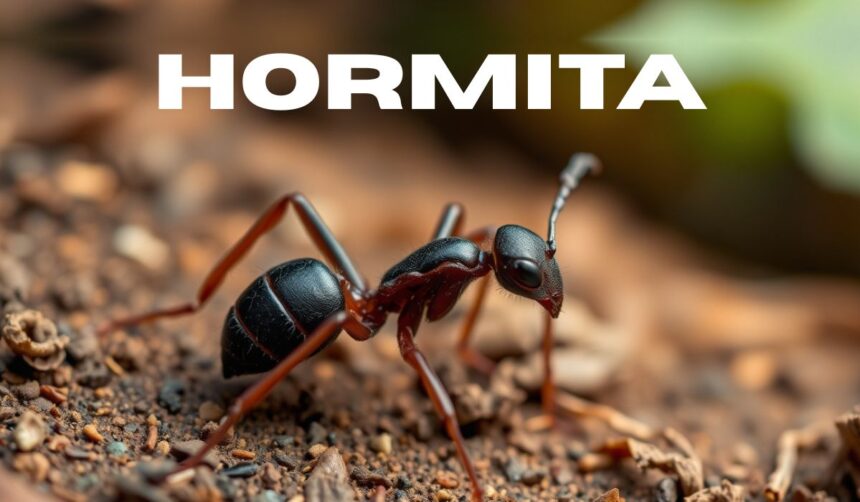The Hormita ant is one of nature’s lesser-known marvels—a small yet highly organized insect species that plays a vital role in maintaining ecological balance. While not as famous as fire ants or carpenter ants, Hormita ants have a fascinating biology and lifestyle that make them worth studying. Their distribution, nesting habits, and environmental impact reveal just how interconnected our natural world truly is. This article dives deep into where Hormita ants live, how they build their colonies, and their ecological significance in various ecosystems.
Understanding the Hormita Ant
The Hormita ant is a ground-dwelling species that thrives in warm, humid environments. Like many members of the Formicidae family, it exhibits complex social structures, communication systems, and cooperative behaviors that ensure the survival of its colonies. Hormita ants are often recognized for their dark exoskeletons, segmented bodies, and efficient foraging techniques. Their presence in certain regions can indicate a healthy, balanced environment where organic matter is actively decomposing and recycled into the soil.
Geographic Distribution of Hormita Ants
Hormita ants are found in tropical and subtropical regions, particularly throughout Central and South America, parts of Southeast Asia, and sub-Saharan Africa. In the U.S., related species have been observed in southern states like Florida, Texas, and Louisiana, where the climate offers ideal warmth and humidity. These ants prefer environments that provide shade and moisture, often avoiding overly dry or cold regions.
In forest ecosystems, Hormita ants thrive beneath layers of fallen leaves and decaying logs, using the natural canopy to shield themselves from direct sunlight. Their colonies are also common in agricultural lands and suburban gardens where organic material is plentiful. This adaptability allows Hormita ants to flourish in both natural and semi-disturbed habitats.
Preferred Habitat Conditions

Hormita ants are soil-nesting insects that require specific microclimatic conditions to survive. They prefer moist, well-drained soil, which helps maintain the temperature and humidity levels necessary for egg and larval development. You can often find them beneath tree roots, leaf litter, and decomposing plant stems.
In urban settings, Hormita ants sometimes establish colonies near garden beds, mulch piles, or beneath patio stones where humidity levels remain stable. They avoid heavily compacted or sandy soils, as these make it difficult to construct and maintain their intricate underground tunnel systems. These ants rely on natural debris to insulate their nests from environmental fluctuations, making them important contributors to soil structure and health.
Nesting Behavior and Colony Structure
One of the most fascinating aspects of the Hormita ant is its nesting behavior. Their nests are elaborate underground systems that may extend several feet below the surface. Each colony is divided into functional chambers designed for specific purposes—brood rearing, food storage, and housing for the queen and workers.
The queen is the heart of the colony, responsible for laying thousands of eggs over her lifespan. Worker ants, which are sterile females, perform all essential duties: foraging for food, caring for the larvae, defending the nest, and maintaining tunnel structures. The soldier ants, larger and equipped with stronger mandibles, act as defenders, protecting the colony from invaders such as spiders or other ant species. This intricate social system ensures that every member plays a part in the survival and prosperity of the colony.
Feeding Habits and Foraging Behavior
Hormita ants are omnivorous scavengers, feeding on a diverse diet that includes small insects, plant material, nectar, fungi, and organic debris. Their foraging behavior is highly coordinated—worker ants leave the nest in search of food, leaving behind chemical pheromone trails that guide others to the same location.
In forests, these ants help recycle nutrients by breaking down decaying plant matter and preying on smaller insects. In agricultural settings, they can benefit crops by feeding on pest larvae and improving soil aeration through their tunneling activity. However, when populations grow too large, they can sometimes become a nuisance around human dwellings, especially in moist gardens or compost areas.
Communication and Social Organization
Like most ant species, Hormita ants rely heavily on chemical communication. Pheromones play a critical role in coordinating activities such as foraging, defense, and reproduction. A single pheromone trail can mobilize hundreds of worker ants within minutes, demonstrating their remarkable efficiency.
Inside the colony, communication extends to tactile interactions—ants use their antennae to recognize each other and detect environmental changes. This social intelligence enables Hormita colonies to respond collectively to threats, food sources, and environmental shifts. Such cooperation has fascinated entomologists for decades and provides insight into the advanced evolutionary strategies that define insect societies.
Ecological Role and Environmental Impact
Hormita ants are key ecological engineers. Their digging and foraging activities promote soil aeration, which enhances water infiltration and nutrient cycling. They also contribute to decomposition, breaking down organic matter and redistributing nutrients essential for plant growth.
Additionally, some species of Hormita ants participate in seed dispersal, a process known as myrmecochory. By collecting and transporting seeds, they help maintain plant diversity and regeneration in forest ecosystems. Their predatory behavior helps regulate populations of small arthropods, keeping natural pest numbers in check. In essence, Hormita ants are silent custodians of soil fertility and forest health.
Adaptation and Survival Strategies
Hormita ants have developed several adaptations that enable them to survive in challenging environments. Their exoskeleton helps prevent moisture loss, and their ability to regulate nest humidity ensures the survival of their brood. When faced with threats such as flooding or drought, colonies may relocate to higher ground or build additional chambers for safety.
In regions with distinct wet and dry seasons, Hormita ants adjust their foraging activity to coincide with periods of optimal food availability. They are also capable of rapid recovery following disturbances like heavy rain or habitat disruption, demonstrating their resilience and adaptability in a changing environment.
Threats and Conservation Concerns
Although Hormita ants are generally resilient, their populations can be impacted by deforestation, habitat loss, and pesticide use. The destruction of natural forests and the overuse of chemical insecticides can disrupt colony stability and reduce biodiversity. Because these ants contribute to soil health and ecosystem balance, protecting their natural habitats indirectly supports larger environmental goals.
Conservationists emphasize the importance of integrated pest management (IPM) practices that minimize harm to beneficial insects like Hormita ants. Promoting native vegetation and reducing soil compaction in agricultural and urban areas can also help maintain their populations and ecological contributions.
Hormita Ants and Human Interaction
In most cases, Hormita ants coexist peacefully with humans. Their foraging activities rarely cause structural damage, and they contribute to controlling other pest species. Gardeners often appreciate their role in breaking down organic material, though they may occasionally invade moist indoor spaces in search of food.
Educating the public about these ants’ ecological importance can foster better coexistence. Rather than eliminating them outright, homeowners can manage colonies responsibly by reducing food sources and maintaining proper sanitation. Understanding that Hormita ants are part of a larger ecological network helps promote a more balanced relationship between people and nature.
Scientific Significance and Ongoing Research
Researchers continue to study Hormita ants to understand their genetics, communication systems, and symbiotic relationships with other organisms. Studies have shown that their colonies can influence soil microbiomes and even enhance plant root health. The Hormita ant’s complex social behavior offers valuable insights into cooperative evolution, adaptability, and environmental resilience.
As climate change alters global ecosystems, scientists are particularly interested in how Hormita ants adjust their nesting and foraging patterns. Tracking their distribution provides key data on shifting ecological conditions and biodiversity trends across tropical and subtropical regions.
Final Thoughts
The Hormita ant is a remarkable example of nature’s precision and balance. Its distribution, nesting habits, and ecological impact highlight how even the smallest species play a crucial role in sustaining life on Earth. By understanding where Hormita ants live and how they contribute to soil health and ecosystem stability, we gain greater appreciation for the interconnectedness of all living things.
Protecting these ants means protecting the environments they support—forests, grasslands, and farmlands that sustain both wildlife and human life. In a world facing rapid environmental change, observing and learning from species like the Hormita ant reminds us that ecological strength begins with diversity and cooperation.
Frequently Asked Questions (FAQs)
1. What type of environment do Hormita ants prefer?
Hormita ants prefer warm, humid environments with moist soil and plenty of organic material. They are often found in tropical forests, gardens, and shaded urban areas where humidity levels are stable.
2. Are Hormita ants dangerous to humans or pets?
No, Hormita ants are not aggressive toward humans or pets. They may bite if disturbed, but they do not sting or pose significant health risks. In fact, they are considered beneficial to gardens and ecosystems.
3. What do Hormita ants eat?
Hormita ants are omnivorous scavengers that feed on insects, decaying plants, fungi, and nectar. Their diverse diet helps recycle nutrients and maintain a healthy soil ecosystem.
4. How can I identify a Hormita ant colony?
Hormita ant nests are typically found under leaf litter, logs, or soil mounds. Look for small entrance holes surrounded by loose soil and active foraging trails during the early morning or late afternoon.
5. Why are Hormita ants important for the environment?
Hormita ants improve soil structure, aid in decomposition, and help disperse seeds. Their ecological activities support plant growth, nutrient cycling, and pest control, making them vital to ecosystem balance.
FOR MORE : FLIPPAMAGAZINE












